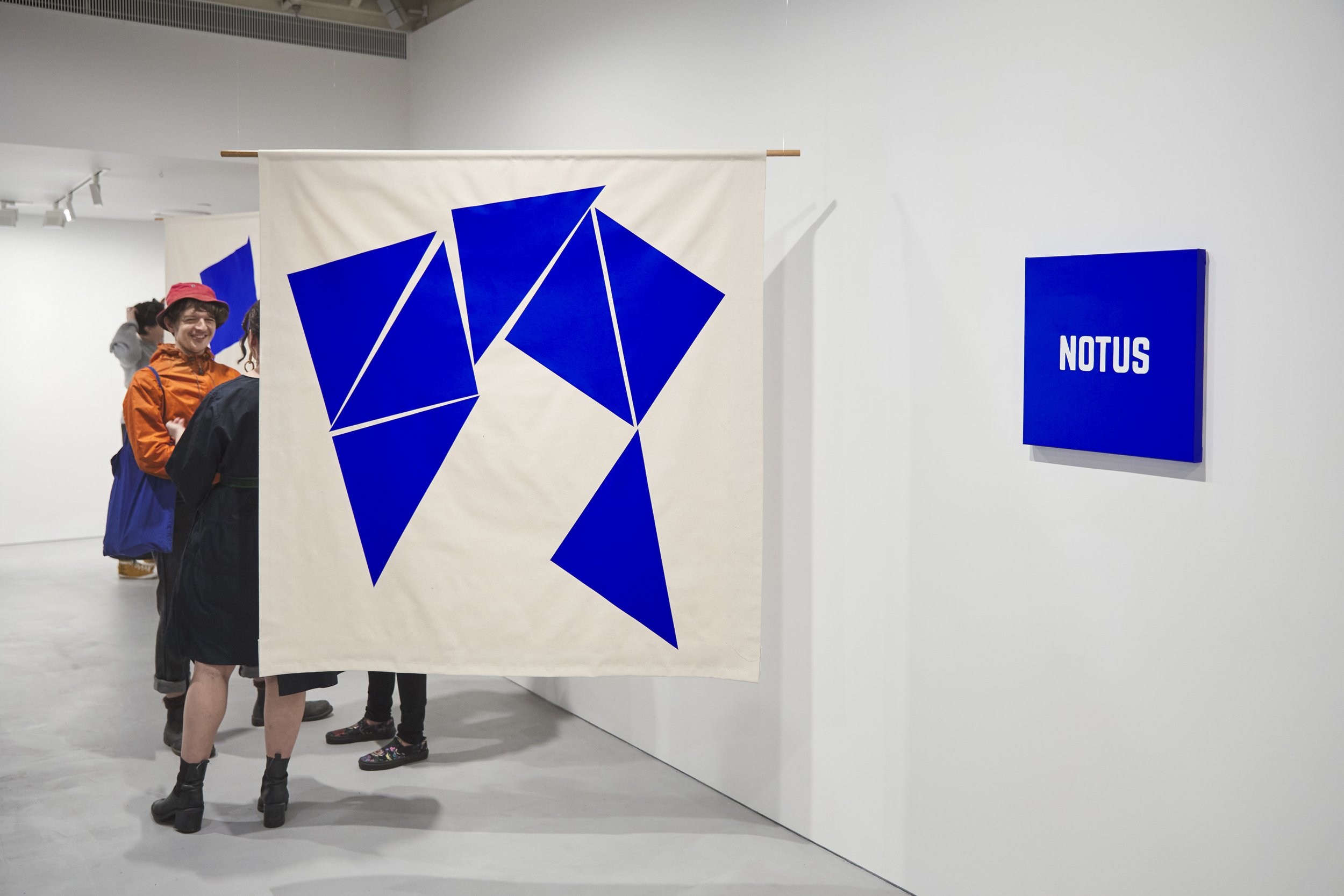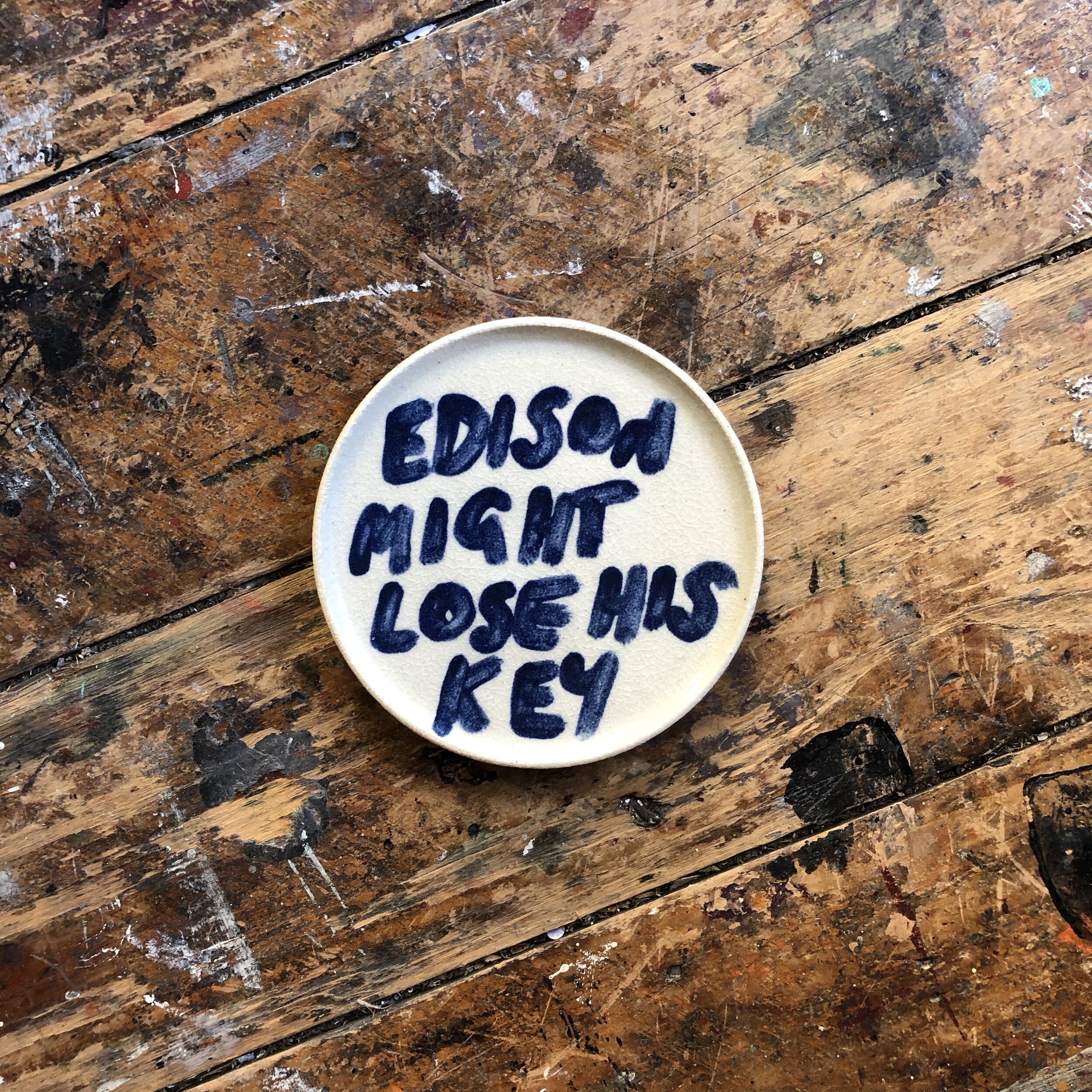works & exhibtions
Perfect Black Suprematist Square Dissections (order 21)
Fruit/berry/herb: an irregular plural (Rubicon ARI, 2024)
The banana is a berry that grows upon a herbaceous flowering plant with a false stem. It is a singularly diverse fruit/berry/herb that, in an era increasingly insensitive and inattentive to difference, offers an absurd symbol of nuance.Taking its false botanical stem as a false linguistic stem, Fruit/berry/herb: an irregular plural articulates an alternative grammatical numbering system for the plural form of banana. It proposes that for each banana additional to the singular “banana”, a further “-na” is appended such that the full range of its conceptual flavours may be appreciated.
The Dictionaary Perkins & Rote (2023)
Compiled from typos encountered throughout Perkins’ reading practice since 2017, The Dictionaary Perkins is an absurd and idiolectical supplementary update to the dictionary. It coalesces around the so-called Wicked Bible's (1631 KJV) infamous seventh commandment that “Thou shalt commit adultery”.
Taking this omission of ‘not’ as gospel, Perkins treats all the ‘typos’ he has collected as intentional and as evidence of the English language’s evolution. Perkins then applies The Dictionaary Perkins to various texts as a strategy of grammatic abstraction. For Rote (The Wicked Bible), he trained ChatGPT — an artificially intelligent chatbot — on this idiolect to generate an absurd (and entirely immoral) version of Exodus 20:2-17; for Rote (The Ten Commandments) Perkins playfully restates a list of common laundry instructions. Through each of these works Perkins disrupts comprehension, prompting a consideration of how we know what we know.
Six characters in search of an author (Five Walls, 2023)
Taking its title from an early 20th century meta-theatrical absurdist play written by Luigi Pirandello, Six characters in search of an author interrogates the story we each tell ourself about our own self through a suite of text-based works.A life does not progress through stages of rising action, climax, and falling action towards resolution. Instead, it occurs as an undifferentiated sequence of experiences of varying importance that are only given coherence through a narrativisation of self. Enter/Exeunt You draws attention to this process, offering a set of stage directions to its viewer that emphasise their movement between the accompanying paintings. The Termini works each draw an analogy between the material processes of painting and the process of self-narrativisation. Like the story we each tell ourself about our own self, the composite forms that emerge from within the construction lines, brushwork, and incidental smudges and drips are ones that have been reinforced through repetition and continual refinement.
The process of self-narrativisation is one that is mediated by fiction and ultimately generative of another: an autofiction unique to each individual through which we interact with reality. Like Pirandello’s play, Six characters in search of an author brings this to the fore.
If I were taller (Jan Manton Gallery, 2022)
If I were taller is a work of fiction. Its names, characters, places, and incidents are used fictitiously, regardless of their autobiographical, imaginary, or real world origin. I state this not to disclaim any connection between fiction and reality, but, instead, to confirm it. The exhibtion engages fiction within pictorial and textual works to explore a fiction that we encounter every day: the story we each tell ourself about our own self.The titular short story is set in a typeface of my own design entitled Aalphabet. It contains upper- and lower-case forms of the 26 letters within the English alphabet and a selection of diacritical and punctuation marks. Each character was made using the same process as that which gives form to each figure within the paintings.
Termini (Subtractive) and Personae (2022)
The Termini series uses painting to explore the the story we each tell ourself about our own self. Made by overlaying all the typographic variations available within a single font family, the works draw an analogy between the material processes of painting and the linguistic processes of self-narrativisation. From within the construction lines, brushwork, and incidental smudges and drips — a kind of painted marginalia — the composite form emerges that emerges within each work is one that has been reinforced through repetition and continual refinement.Cherry Stones (IN | ari x The Old Lock Up, 2021)
A. A. Milne’s Cherry Stones is a children’s poem that wonders about what life will bring. The child asks whether they’ll be a tinker, tailor, soldier or a sailor; whether they’ll be rich or poor, virtuous or corrupt; and whether they’ll turn rabbits out of their pockets or travel through space on rockets. They wonder at the seemingly inexhaustible possibilities for life and liken this to the abundance of cherries growing upon the little cherry tree in their garden. Yet the poem’s title, “Cherry Stones”, perhaps reflects a diminished view from adulthood: that with each choice our possibilities successively narrow until all that remains are the consequences of these choices.Artist Aaron Perkins and screenwriter/director Sam Dixon’s Cherry Stones takes inspiration from the children’s games of make-believe that model these choices. Perkins and Dixon’s paintings and writings converse across media to similarly invite make-believe and to offer an imaginative escape from the game of life carried on just outside the pockmarked and graffitied walls of the Old Lock Up.
Pronounced á-nem-oy (Jan Manton Gallery, 2021)
As when the thistles, clumping close together,
are borne across the prairie by the North Wind,
so these winds swept the raft across the sea.
The South Wind hurls it, then the North Wind grabs it,
then East Wind yields and lets the West Wind drive it.
— Homer, The Odyssey, translated by Emily Wilson.
To sail is to read the wind. However, despite a recent residency atop the Maroochy Sailing Club on Chambers Island, Perkins has no experience on rafts, yachts, catamarans or any other masted what-nots. The points of sail are unintelligible to him and his movements over the water are illiterate.
Despite this inexperience, in Pronounced á-nem-oy Perkins nevertheless attempts to harness the wind to continue his exploration of language through abstraction. In a suite of paintings, works on paper, and video that hitch the literature of Ancient Greece to the telegraphic system of flag semaphore, Perkins orients himself within space and language, likening seeds blown by the wind to units of speech, and playfully exploring the evolution of language — albeit sometimes along failed routes...
Collective Invention (after Magritte) (2021)
Self-portrait as a weather front (2020-1)
A synoptic weather chart is usually seen annotated and in animated series behind a gesturing meteorologist to indicate how changes in atmospheric pressure interact with the landscape to produce the week’s weather.Self portrait as a weather front contemplates the relationship between the landscape and the individual. Through a combination of objective and subjective modes of representation it considers people as analogous to the weather: as affecting and affected by their environment, and as erratic and unpredictable in the short term though becoming patterned and predictable over the long term.
Termini (2020-) and Valdetta (2020)
Studies for The Ship of Theseus (2019)
The Ship of Theseus explores visual and linguistic paradoxes through a combination of abstract geometric forms sourced from a collection of Tangram puzzles and text taken from amongst the definitions of contranymic words.Leftovers (2019)
Leftovers takes as its subject matter the existential ruminations, rants and everyday uncertainties of contemporary society uncovered using the search query “I’m worried that”. Plated and set upon the table these words playfully reveal a self-affirming yet egalitarian portrait of contemporary society.Double-A-BCD-to-Y&Z-skipping-I and Pro-Verbs (2019)
Materially comprising gouache on an altered and rebound Grosset Webster Dictionary (New York: Grosset & Dunlap Inc, 1974), Double-A-BCD-to-Y&Z-skipping-I is an autofictional artist’s book that explores the onomastic correspondence between author, narrator, and protagonist characteristic of literary autofiction.
Pro-verbs is an artist’s book in gouache on pages from an altered and rebound Oxford Illustrated Dictionary (London: Oxford University Press, 1962). It contrasts the lexicographic objectivity of a typeset dictionary with the autographic subjectivity of my own handwriting to define an identity – an ‘I’ — through the selective re-presentation of its contents.
Other (2017-18)



















































































































































































